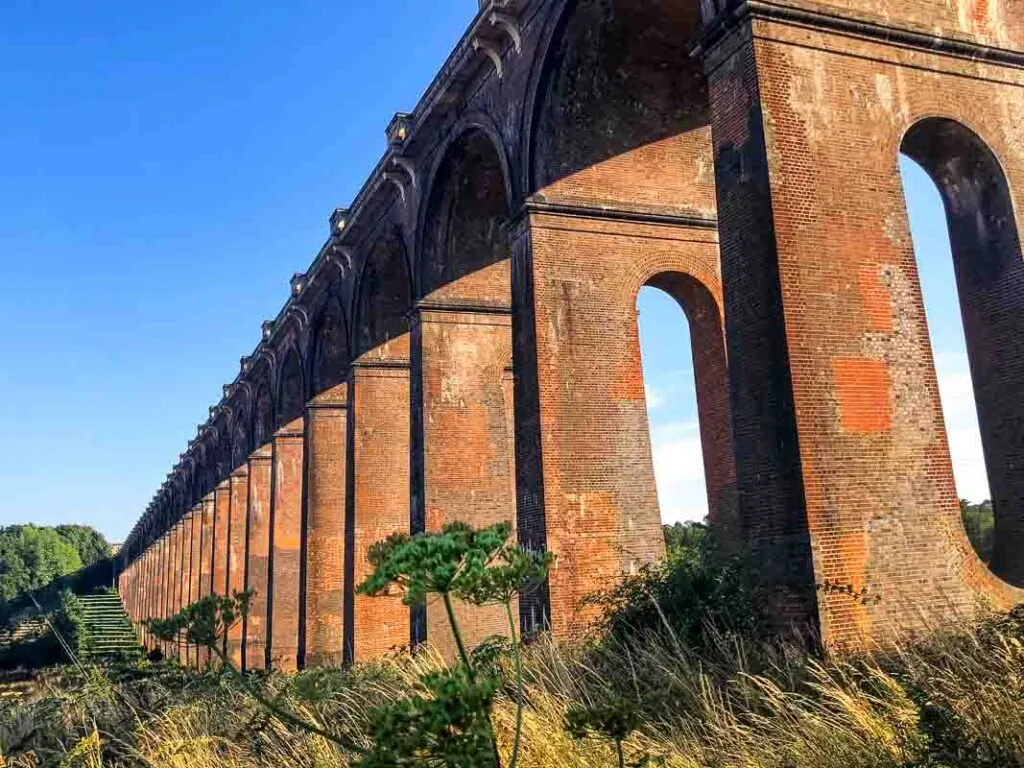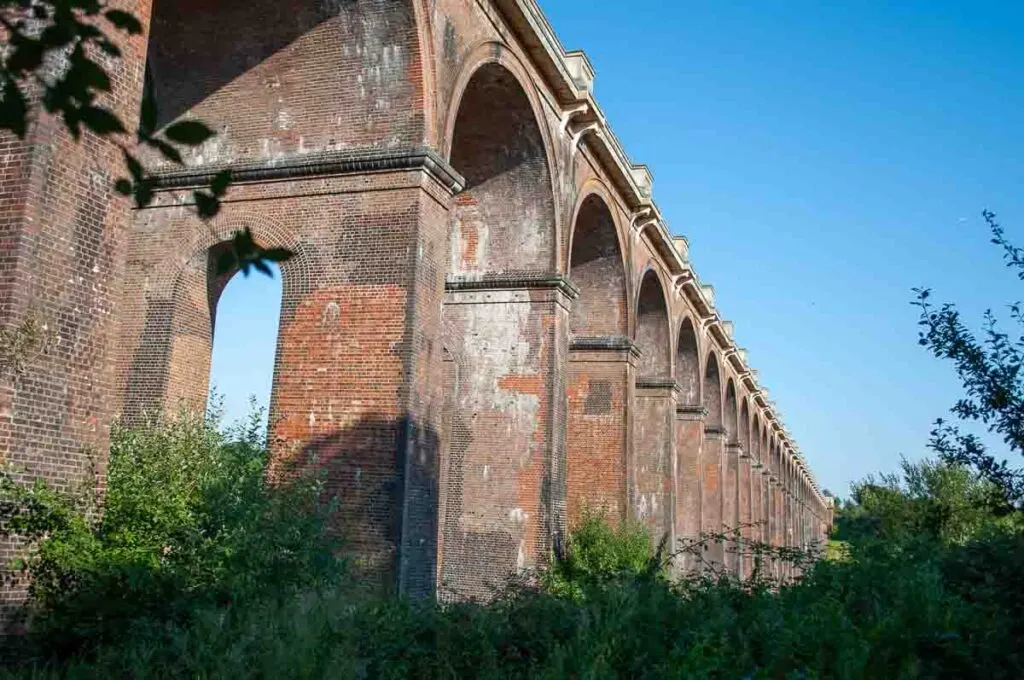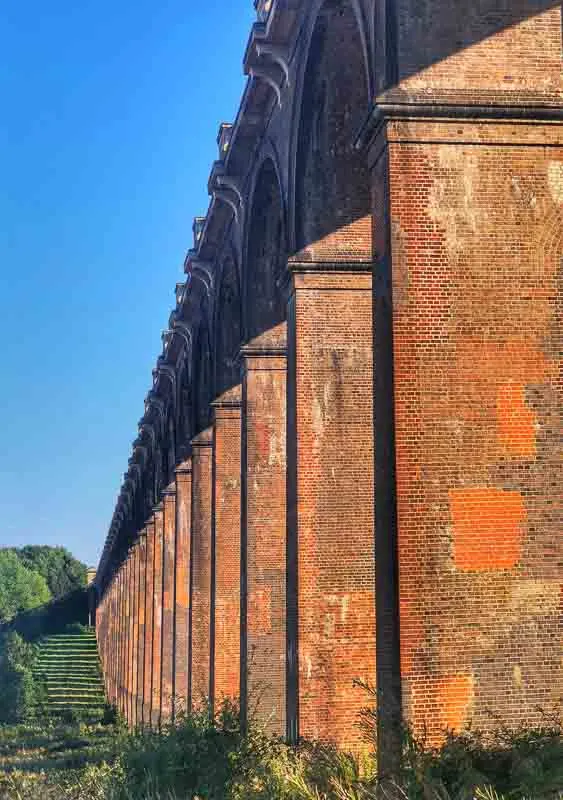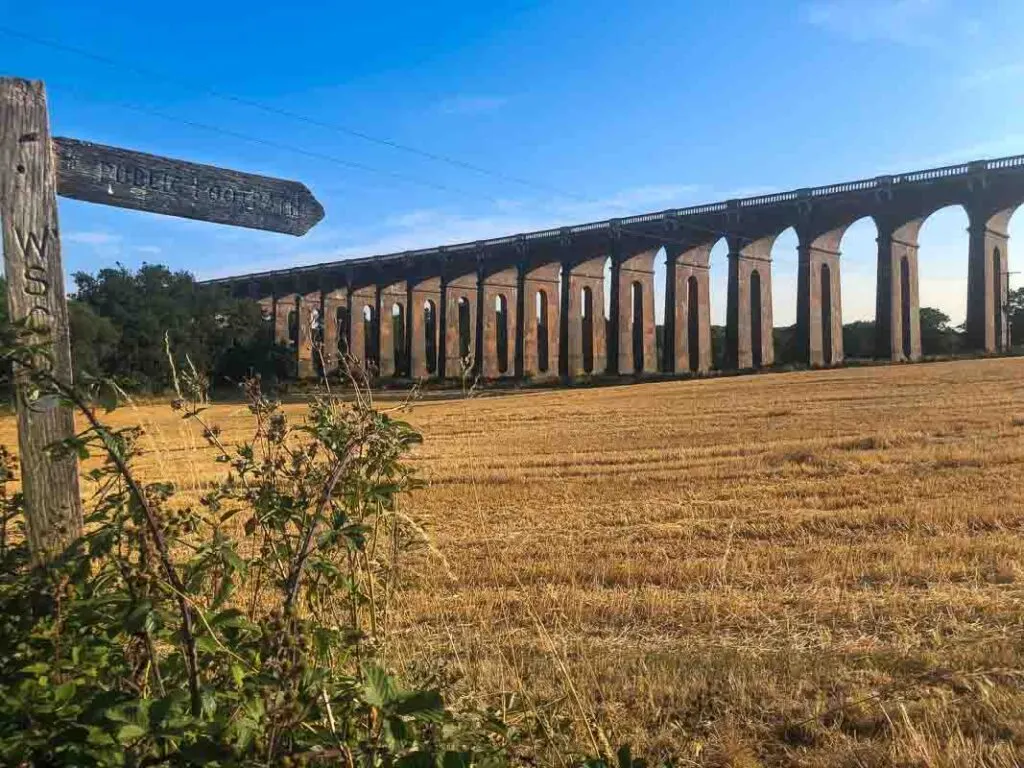If you’ve taken the train from London Victoria to Brighton, you’ll have passed over the Ouse Valley Viaduct in West Sussex. And I’m guessing, like me, you probably didn’t even notice the architectural beauty beneath you as you raced along the tracks.

Ouse Valley Viaduct has been described as “the most elegant viaduct in Britain”. By whom I’m not sure, but I think they’re probably right. Not only is it beautiful and dramatic but this architectural marvel in southern England is a photographer’s dream and one of the most unusual places to visit in West Sussex.
This post may contain affiliate links, which means that we may earn a small commission, at no extra cost to you, for qualifying purchases. More info: disclosure.

In this guide to visiting Ouse Valley Viaduct (pronounced ‘ooze’ btw) we’ll delve into the history of this stunning structure and the fascinating facts and figures behind its construction. After reading more about it you may want to visit so I’m also sharing information and useful tips on how to visit the viaduct for yourself.
Where is Ouse Valley Viaduct?

This iconic red brick viaduct sits in a remote countryside location north of Haywards Heath and south of the village of Balcombe, West Sussex in South East England.
Stretching over the River Ouse, in a beautiful green valley, the viaduct is the main rail link for the London to Brighton railway line showcasing an engineering feat of 37 brick-built arches.
Also known as Balcombe Viaduct, it’s a significant West Sussex landmark and well worth a visit because it’s so much more than a transport link from London to Brighton.
Why you should visit Ouse Valley Viaduct
Trainspotters and historical engineering buffs visit Ouse Valley Viaduct for obvious reasons. But did you know the viaduct is probably the most photographed viaduct in England? Despite its practicality, the viaduct is a masterpiece of engineering and beneath the train track lies a mesmerising optical illusion.
Stand at the end of the viaduct for a unique photo opportunity with a view of the red brick piers stretching seemingly into infinity.
The ornate design is also good to photograph from the surrounding fields. A great place to get shots of the full length of the viaduct is from the field behind it. This is also where trainspotters will get great views of the trains crossing.
Ouse Valley Viaduct is one of my favourite Sussex photography spots along with Brighton’s ruined West Pier and the Seven Sisters Cliffs. If I’m driving in the area I always make time to stop by for a glimpse of this structural marvel set amid the beautiful West Sussex countryside.

Ouse Valley Viaduct History
There’s an interesting history behind the Victorian viaduct. It all started in July 1837 when an act of Parliament allowed London and Brighton Railway company to construct a railway line between London and the south coast.
Sir John Rennie and his team selected the most direct route from north to south. However, the route was geographically challenged due to the rolling hills of the south downs which meant that four tunnels were required, plus one viaduct, south of Balcombe.
John Urpeth Rastrick, principal engineer, designed this architectural masterpiece in association with architect David Mocatta of the London-Brighton railway line. Construction of the Ouse Valley viaduct began in 1839 by construction company Baylis. It opened two years later 12th July 1841.
The main materials used for the Grade II listed structure are bricks and stone. It’s said that the red bricks were made from local Sussex clay while other reports state they where made in the Netherlands. Being Sussex born and bred, I like to think they were from Sussex.
Limestone was sourced from Caen in Normandy and shipped to Newhaven before being transported up the river Ouse by boat. The Caen stone was used for the balustraded parapets, pier caps and the four small pavilions at each end of the viaduct.
Repairs to the viaduct

Extensive repairs have been undertaken over the years. The lime motor in the brickwork was repalced with cement in the 1890s. Essential restorations took place in March 1996 when the viaduct underwent a massive £6.5 million renovation.
Funded by grants from West Sussex County Council, the Railway Heritage Trust and English Heritage, the work took three years to complete. Trains continued to run throughout the restoration.
The ornate viaduct was built to last 120 years. It’s impressive that it’s stood the test of time and is still carrying trains over the Ouse River and through the Sussex countryside over 180 years later.
Some Ouse Valley Viaduct Facts and Figures
Ready for some number crunching? Read on for some interesting facts and figures about the viaduct.

If you’ve ever wondered what 11 million bricks look like, you’ll find out at Ouse Valley viaduct. Although you won’t strictly see this number of bricks because some are underground forming the foundations.
Ouse Valley Viaduct is a total length of 450 metres (1,480 feet) long and 29 metres (95.14 feet) high.
There are 37 semi-circular arches each spanning 9.1 metres (30 feet) which support the bridge. Each pier has a jack arch with a semi circular soffit which reduced the number of bricks required for the build.


Eight decorative limestone pavilions adorn the top of the viaduct. Four at each end.
The cost of building the viaduct was £38,500 which is equivalent to approximately £3.5 million today. That’s a little more than half the cost of the 1996-99 renovations
Trains and Routes

Over 100 trains pass over the viaduct each day. Most are commuter trains on the London to Brighton Main Line, which links the capital city with the south coast. The Gatwick Express also uses the viaduct every day along with trains from other lines like Thameslink.
Last time I took the train to Gatwick I made sure to look out of the window as we passed over the viaduct. I can confirm it’s definitely more impressive looking up at it from ground level.
Ouse Valley Viaduct Photography Tips

Previously only known to locals and train spotters, the Ouse Valley viaduct is now a popular Instagram hotspot, and it can get pretty busy. Pick your time and go during the week or early in the day.
The best view is at the northern end of the viaduct under the first archway. You can head further down but the infinity illusion lessens the further in you go.
Avoid the brightest time of day, around lunch time, when you might experience lens flare. The best lighting is early-mid morning when shafts of sunlight sit on the base of the arches.
Go later in the day during summer between mid-afternoon and sunset and you’ll get long shadows stretching across the cornfield. If you’re lucky you might capture a starburst through one of the arches before the sun dips behind the trees.
Visit at different times of year. The viaduct takes on a unique vibe with each season, especially during vibrant autumns and late summer afternoons.



If you want to get up onto one of arches for a photo you might need a friend to help you climb up. I’m quite short and we had quite a laugh trying to climb up. The arches are a lot higher than they look. Said friend is also then available to take your photo.
The flying of drones in and around Ouse Valley Viaduct is strictly prohibited.
Walks and Hiking

You’ll need to take a short walk from Ardingly Reservoir car park to get to the viaduct it’s around 2.2km and takes about half an hour.
There are a number of other walks in the area including a circular walk from the reservoir or the walk from Balcombe station to the viaduct which is around 3km. A longer 13km scenic hike can be taken from Haywards Heath station is you have more time.
You can find directions for all these walks on this Ordnance Survey Map or you can subscribe to an online version.
How to visit Ouse Valley Viaduct

Getting to the viaduct
To locate Balcombe Viaduct:
Address: Borde Hill Ln, Haywards Heath RH17 6QR
What Three Words: dame.riverside.text
Map co-ordinates are: 51°02′05″N 0°06′52″W
By Train
Take the train, the most appropriate form of transport, I think. Travel on the London-Brighton line from London Victoria to Balcombe train station. From there it’s a 3.5 km walk (2 miles) to the viaduct via Ardingly Reservoir.
By Car from London
From the M25 take the M23 towards West Sussex. At junction 7, take the M23 S exit to Brighton/Gatwick Airport.
At Crawley Interchange, take the 1st exit onto Copthorne Way/A264. Stay on this road until you reach Dukes Head Roundabout, take the 3rd exit onto Turners Hill Rd/B2028.
Keep on B2028 until you reach the village of Ardingly. Just past the Ardingly Inn take the right hand fork onto College Road.
Pass Ardingly College and take the next right. Look out for the ‘Reservoir’ sign. Follow the road taking a left and a right and you’ll find the car park to your right.
Car Park Postcode: RH17 6SQ
Ouse Valley Viaduct Parking
If you are driving, I recommend you use the car park at nearby Ardingly Reservoir car park (RH17 6SQ) which is free. (Directions above) From there it’s a pleasant 2.2 km (1.36 miles) short walk through the countryside which takes around 30 minutes. You’ll get panoramic views of the viaduct as you approach from the field across the road.
For Ouse Valley viaduct parking please don’t park on Borde Hill Lane. The road is narrow with fast moving traffic and it’s undesignated parking with room for just 3-4 cars on the grass verge. I also don’t recommend parking at Borde Hill Gardens and walking via Borde Hill Lane. There’s no pavement on the road and traffic is fast.
The public footpath through the field where the viaduct stands is on farmland. Treat the land with respect, keep to the path and follow the Countryside Code. In winter it gets muddy, so you’ll want good walking boots or wellies.
Things to do near to Balcombe Viaduct
If you’ve travelled by car and want to visit some Sussex Gardens then Borde Hill Gardens, Nymans, High Beeches and Wakehurst are all both close by.
If you enjoy water activities then spend time at Ardingly Activity Centre where you’ll find kayaking, paddle boarding and wind surfing on the reservoir. Take a picnic lunch to enjoy by the water.
I hope you’ve found this post useful for a visit to this stunning spot. It’s a good place to visit en-route to Brighton on a day trip. The viaduct offers an eye-pleasing blend of Victorian gothic architecture and impressive structural engineering in the High Weald AONB.
I think Ouse Valley Viaduct is one of the most unique attractions in West Sussex. Have you been? Do you agree?



Suzanne Jones is owner and editor at Hello Sussex which was founded in 2017. When she’s not exploring Sussex or writing about it you’ll most likely find her, camera in hand, enjoying coastal and countryside hikes across the county.
Suzanne is also travel writer and content creator at top travel blog The Travelbunny which she founded in 2011.





